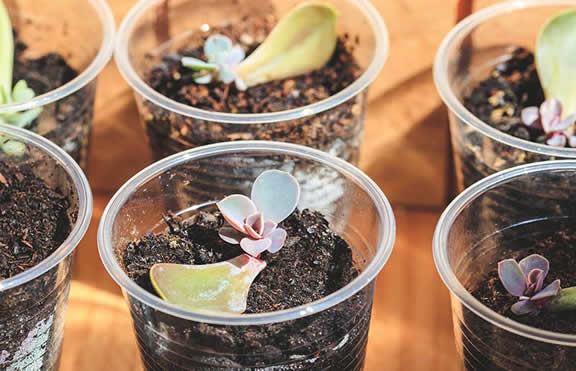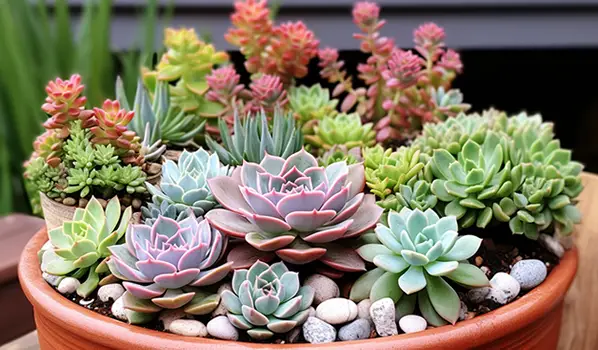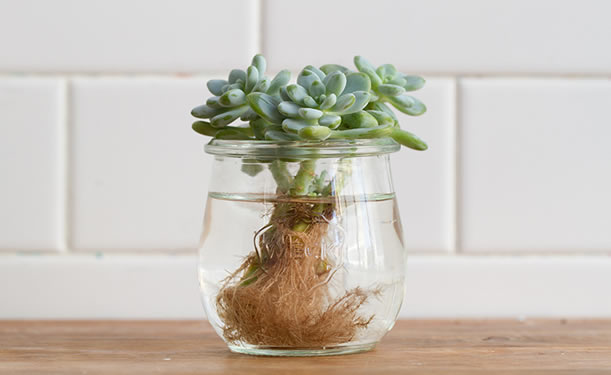How To Propagate Succulents From Leaf, Stem & Offset

Succulent propagation is a popular and rewarding way to grow new plants from existing ones. Here are general steps for propagating succulents through leaf or stem cuttings:
Table of Contents
Initial Steps For Succulent Propagation
Parent plant selection
Select a mature and healthy succulent plant for propagation.
It should be free from pests and diseases.
Decide on propagation method
Succulents can be propagated from leaf cuttings or stem cuttings.
In many succulents you can also propagate new plants from offsets that grow from the main plant.

I have included a guide to propagating succulents from offsets below but if you plant to propagate aloe from offsets you may want to go directly to our detailed guide to propagating aloe plants from offsets (often called baby aloe and aloe pups).
So the 3 methods for succulent propagation are:
- Propagation from leaf
- Propagation from stems
- Propagation from offsets
In addition to the 3 methods for propagation there are 2 mediums in which to propagate your succulent.
You can propagate succulents in:
- Soil
- Water.
Choose the method based on the type of succulent you have.
If your succulent has offsets then this should be your primary method for propagation as it will yield the best results.
Succulent Propagation from Leaf or Stems
Materials Needed:
- Healthy succulent plant
- Clean, sharp scissors or pruning shears
- Well-draining succulent or cactus potting mix
- Small pots or containers with drainage holes
- Rooting hormone (optional)
- Plastic or glass tray for collecting leaves (for leaf propagation)
Succulent Leaf Propagation
Select only healthy leaves
Choose plump, healthy leaves from the bottom of the plant.
Gently twist or cut the leaves close to the stem.
Let Leaves Callus
Allow the cut ends of the leaves to dry and callus for a day or two.
This helps prevent rot when planting.
Plant the leaves
Place the dried leaves on top of well-draining succulent soil in a shallow tray or directly in small pots.

Press the cut end slightly into the soil.
Water sparingly
Water the soil lightly, and then allow it to dry out between waterings.
Overwatering can lead to rot.
Wait for roots and new growth
Roots will begin to form from the base of the leaves, and new plantlets will emerge.
This process may take several weeks to months.
Succulent Stem Cutting Propagation
Cut healthy stems
Use clean, sharp scissors or pruning shears to cut healthy stems from the parent plant.
Each cutting should be a few inches long.
Allow the cuttings to dry
Let the cut ends of the stems dry and callus for a day or two.
Optional: Apply rooting hormone
If desired, dip the cut end of each stem into rooting hormone to encourage root development.
Using this little trick will greatly improve your results.
Plant the stem cuttings
Plant the dried stems into well-draining succulent soil.

Bury the cut end into the soil and water lightly.
Water Sparingly
Water the soil sparingly and allow it to dry out between waterings.
Wait for Roots and New Growth
Roots will develop from the cut ends, and new growth will emerge from the top of the stems.
This may take several weeks.
Transplanting
Once the new plants have developed roots and are large enough, transplant them into individual pots or their final growing location.
Succulent Propagation From Offsets
Propagating succulents from offsets, also known as pups or offshoots, is a common and straightforward method.
Here are the steps to propagate succulents from offsets:
Materials Needed:
- Parent succulent with offsets
- Clean, sharp scissors or pruning shears
- Well-draining succulent or cactus potting mix
- Small pots or containers with drainage holes
Select a healthy parent plant
Choose a mature and healthy succulent plant that has produced offsets.
Ensure that both the parent plant and the offsets are free from pests and diseases.
Identify and inspect offsets
Locate the offsets or pups around the base of the parent plant.
Inspect them to ensure they have developed roots of their own.
Separate the Offsets
Use clean and sharp scissors or pruning shears to carefully cut the offsets from the parent plant.

Ensure that each offset has roots attached before cutting it from the parent plant.
Allow Cut Ends to Dry
Let the cut ends of the offsets dry and callus for a day or two.
This helps prevent rot when planting.
Prepare planting containers
Fill small pots or containers with well-draining succulent or cactus potting mix.
Ensure the containers have drainage holes to prevent waterlogging.
Plant the Offsets
Use a good succulent soil as this will provide the appropriate drainage.
Insert the dried ends of the offsets into the soil, burying the roots.
Gently firm the soil around the base of each offset.
Water sparingly
Water the newly planted offsets lightly.
Allow the soil to dry out between waterings to prevent overwatering.
Provide the new plant with good indirect light
Place the pots with the newly planted offsets in a location with indirect sunlight.
Avoid exposing them to direct sunlight until they have established.
Monitor the plant’s growth
Keep an eye on the offsets for signs of growth.
They should start developing roots and new leaves over the coming weeks.
Transplant to bigger pots as needed
Once the offsets have grown larger and established themselves, you can transplant them into individual pots or their final growing location.

Remember to be gentle during the separation process and handle the offsets with care to avoid damage.
Succulents are generally resilient, and with the right care, propagated offsets can develop into healthy, mature plants.
Succulent Propagation In Water
Materials Needed:
- A parent succulent with healthy leaves
- Clean, sharp scissors or pruning shears
- A container that can hold water and your cutting
- Rooting hormone & liquid floral vase flower feed (optional)
Select healthy leaves or stems
Choose healthy leaves or stems from the parent succulent.
Ensure they are free from damage or pests.
Allow cut ends to dry
If you’re using stem cuttings, allow the cut ends to dry and callus for a day or two.
This step is less critical for leaf cuttings.
Fill the container with water
Fill a clear glass or plastic container with enough water to submerge the cut ends of the succulent leaves or stems.
You can even use a water bottle as long as it contains enough water so that the end of the succulent cutting is submerged. The entire cutting should not be submerged.
Optional: Use rooting hormone
If desired, dip the cut ends of the succulent leaves or stems in rooting hormone.
This can help stimulate root growth.
Place the succulent cuttings in water
Submerge the cut ends of the succulent leaves or stems in the water.

Ensure that only the cut ends are in water and not the entire leaf or stem.
Optional: Use a liquid floral vase feed
To give the cutting an even better chance of rooting I advise you to mix into the water a few drops of little liquid floral feed.
Position in strong indirect light
Place the container in a location with indirect sunlight.
Avoid direct sunlight, as it could lead to excessive heat and algae growth in the water.
Change the water regularly
Change the water every few days to ensure it stays clean and doesn’t develop mold or bacterial growth.
Be sure to add a few drops of floral feed with every water change if you plan to use this little trick.
Wait for roots to develop
Over the next few weeks, roots should start to develop from the cut ends.
Monitor the progress and be patient.
Transplant rooted cuttings
Once the cuttings have developed sufficient roots (at least a few inches long), they can be transplanted into well-draining succulent soil.
Gradually acclimate the rooted cuttings to soil by burying them in the soil up to the base of the roots.
Water sparingly until they adjust.
Provide care
Continue caring for the newly transplanted succulents as you would for mature plants, ensuring they receive appropriate light and water.
Keep in mind that not all succulent varieties propagate well in water, so results may vary.
Additionally, some succulents may develop roots in water but may not transition successfully to soil.
Experimenting with different varieties can help you understand which succulents respond well to water propagation.
Final Words
Remember, patience is key when propagating succulents.
Each species may have slightly different requirements, so it’s helpful to research specific care guidelines for the succulent variety you are propagating.
Thanks for reading! I'm Michael — houseplant fanatic and your Pinterest plant guide.
Follow me on Pinterest for fresh updates 🌿



